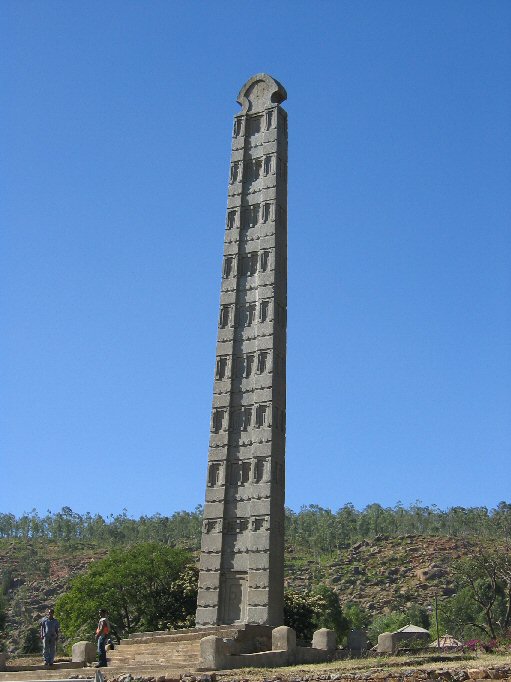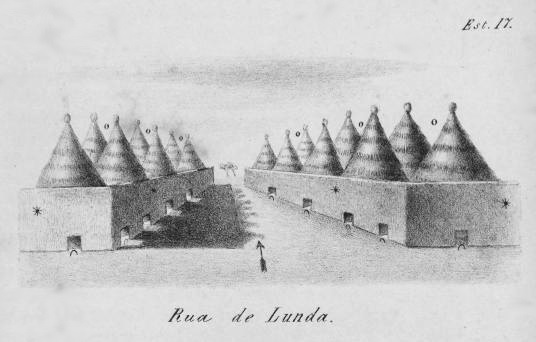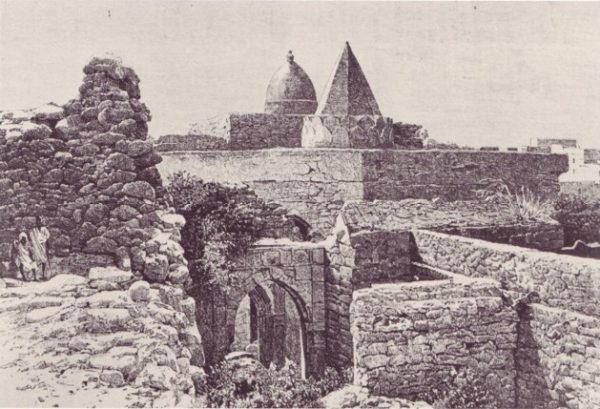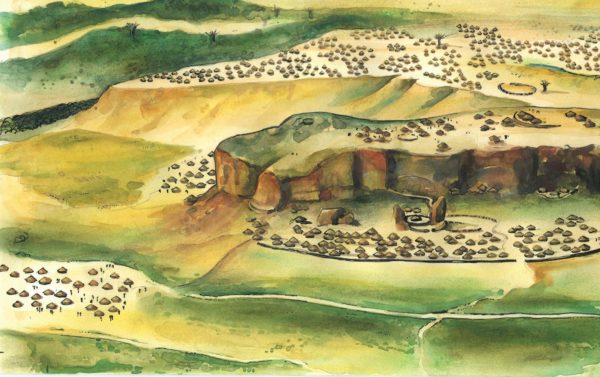11 African Kingdoms No One Talks About But Should

Kingdom of Aksum or Axum of Ethiopia
The Kingdom of Aksum or Axum, also known as the Aksumite Empire, was a trading nation in the area of Eritrea and northern Ethiopia , which existed from approximately 100–940 AD. It grew from the proto-Aksumite Iron Age period c. 4th century BC to achieve prominence by the 1st century AD, and was a major player in the commerce between the Roman Empire and Ancient India. The Aksumite rulers facilitated trade by minting their own currency, the state established its hegemony over the declining Kingdom of Kush and regularly entered the politics of the kingdoms on the Arabian peninsula, eventually extending its rule over the region with the conquest of the Himyarite Kingdom.
The Axumites erected a number of large stelae, which served a religious purpose in pre-Christian times. One of these granite columns is the largest such structure in the world, standing at 90 feet. Under Ezana (fl. 320–360) Aksum adopted Christianity. In the 7th century, early Muslims from Mecca also sought refuge from Quraysh persecution by travelling to the kingdom, a journey known in Islamic history as the First Hijra.
Its ancient capital, also called Aksum, was in northern Ethiopia. The Kingdom used the name "Ethiopia" as early as the 4th century. It is also the alleged resting place of the Ark of the Covenant and the purported home of the Queen of Sheba

Aksum is mentioned in the 1st-century AD Periplus of the Erythraean Sea as an important market place for ivory, which was exported throughout the ancient world. It states that the ruler of Aksum in the 1st century AD was Zoskales, who, besides ruling the kingdom, likewise controlled two harbours on the Red Sea: Adulis (near Massawa) and Assab located in Eritrea. He is also said to have been familiar with Greek literature.
According to the medieval Liber Axumae (Book of Aksum), Aksum's first capital, Mazaber, was built by Itiyopis, son of Cush.

Largely on the basis of Conti Rossini's theories and prolific work on Ethiopian history, Aksum was previously thought to have been founded by Sabaeans, who spoke a language from the Semitic branch of the Afro-Asiatic family. They were believed to have crossed the Red Sea from Southern Arabia (modern Yemen) in antiquity. However, evidence suggests that Semiticized Agaw peoples, who originally spoke other Afro-Asiatic languages from the family's Cushitic branch, and other Ethiopian groups had already established an independent civilisation in the territory before the arrival of the Sabaeans.
Scholars like Stuart Munro-Hay thus point to the existence of an older D'mt or Da'amot kingdom, which flourished in the area between the 10th and 5th centuries BC, prior to the proposed Sabaean migration of the 4th or 5th century BC. They also cite evidence indicating that the Sabaean settlers resided in the region for little more than a few decades. Furthermore, Ge'ez, the ancient Semitic language of Eritrea and Ethiopia, is now known not to have derived from Sabaean, and there is evidence of an Ethiopian Semitic-speaking presence in Eritrea and Ethiopia at least as early as 2000 BC.
Sabaean influence is now thought to have been minor, limited to a few localities, and disappearing after a few decades or a century, perhaps representing a trading or military colony in some sort of symbiosis or military alliance with the civilization of D'mt or some proto-Aksumite state.However, Kitchen et al. (2009) assert that the Ethiosemitic languages were brought to the Ethiopian and Eritrean plateau from the Arabian peninsula around 2850 years ago, an introduction which Ehret (1988) suggests was associated with the establishment of some of the first local complex societies.
Over 95% of Aksum remains unexplored beneath the modern city and its surrounding area.
The Empire of Aksum
The Empire of Aksum at its height at times extended across most of present-day Eritrea, northern Ethiopia, Western Yemen, southern Saudi Arabia and Sudan. The capital city of the empire was Aksum, now in northern Ethiopia. Today a smaller community, the city of Aksum was once a bustling metropolis, cultural and economic center. Two hills and two streams lie on the east and west expanses of the city; perhaps providing the initial impetus for settling this area. Along the hills and plain outside the city, the Aksumites had cemeteries with elaborate grave stones called stelae, or obelisks. Other important cities included Yeha, Hawulti-Melazo, Matara, Adulis, and Qohaito, the last three of which are now in Eritrea.
In the 3rd century, Aksum began intervening in South Arabian affairs, controlling at times the western Tihama region among other areas. It dominated states on the Arabian Peninsula across the Red Sea, making them pay Aksum a regular tribute. By the reign of Endubis in the late 3rd century it had begun minting its own currency and was named by Mani as one of the four great powers of his time along with Persia, Rome, and China. It converted to Christianity in 325 or 328 under King Ezana and was the first state ever to use the image of the cross on its coins. By 350, they conquered the Kingdom of Kush. At its height, Aksum controlled northern Ethiopia, Eritrea, northern Sudan, southern Egypt, Djibouti, Western Yemen, and southern Saudi Arabia, totaling 1.25 million square kilometers.
Around 520, the King Kaleb sent an expedition to Yemen against the Jewish Himyarite King Dhu Nuwas, who was persecuting the Christian/Aksumite community in his kingdom. Dhu Nuwas was deposed and killed and Kaleb appointed a Christian Himyarite, Sumuafa Ashawa, as his viceroy. However, around 525 this viceroy was deposed by the Aksumite general Abreha with support of Ethiopians who had settled in Yemen, and withheld tribute to Kaleb. When Kaleb sent another expedition against Abreha this force defected, killing their commander, and joining Abreha. Another expedition sent against them was defeated, leaving Yemen under Abreha's rule, where he continued to promote the Christian faith until his death, not long after which Yemen was conquered by the Persians. According to Munro-Hay these wars may have been Aksum's swan-song as a great power, with an overall weakening of Aksumite authority and over-expenditure in money and manpower. According to Ethiopian traditions, Kaleb eventually abdicated and retired to a monastery. It is also possible that Ethiopia was affected by the Plague of Justinian around this time.
Aksum remained a strong, though weakened, empire and trading power until the rise of Islam in the 7th century. However, unlike the relations between the Islamic powers and Christian Europe, Aksum (see Sahama), which provided shelter to Muhammad's early followers around 615, was on good terms with its Islamic neighbors.[citation needed] Nevertheless, as early as 640, Umar ibn al-Khattāb sent a naval expedition against Adulis under Alkama bin Mujazziz, but it was eventually defeated. Aksumite naval power also declined throughout the period, though in 702 Aksumite pirates were able to invade the Hejaz and occupy Jeddah. In retaliation, however, Sulayman ibn Abd al-Malik was able to take the Dahlak Archipelago from Aksum, which became Muslim from that point on, though later recovered in the 9th century and vassal to the Emperor of Ethiopia.
Decline
Eventually, the Islamic Empire took control of the Red Sea and most of the Nile, forcing Aksum into economic isolation. Northwest of Aksum in modern day Sudan, the Christian states of Makuria and Alodia lasted till the 13th century before becoming Islamic. Aksum, isolated, nonetheless still remained Christian.
After a second golden age in the early 6th century, the empire began to decline, eventually ceasing its production of coins in the early 7th century. Around this same time, the Aksumite population was forced to go farther inland to the highlands for protection, abandoning Aksum as the capital. Arab writers of the time continued to describe Ethiopia (no longer referred to as Aksum) as an extensive and powerful state, though they had lost control of most of the coast and their tributaries. While land was lost in the north, it was gained in the south, and though Ethiopia was no longer an economic power it still attracted Arab merchants. The capital was moved to a new location, currently unknown, though it may have been called Ku'bar or Jarmi.
Local history holds that around 960 a Jewish Queen named Yodit (Judith) or "Gudit" defeated the empire and burned its churches and literature, but while there is evidence of churches being burned and an invasion around this time, her existence has been questioned by some modern authors. Another possibility is that the Aksumite power was ended by a southern pagan queen named Bani al-Hamwiyah, possibly of the tribe al-Damutah or Damoti (Sidama). It is clear from contemporary sources that a female usurper did indeed rule the country at this time, and that her reign ended some time before 1003. After a short Dark Age, the Aksumite Empire was succeeded by the Agaw Zagwe dynasty in the 11th or 12th century (most likely around 1137), although limited in size and scope. However, Yekuno Amlak, who killed the last Zagwe king and founded the modern Solomonic dynasty around 1270 traced his ancestry and his right to rule from the last emperor of Aksum, Dil Na'od. It should be mentioned that the end of the Aksumite Empire didn't mean the end of Aksumite culture and traditions; for example the architecture of the Zagwe dynasty at Lalibela and Yemrehana Krestos Church shows heavy Askumite influence.
Other reasons for the decline are more scientific in nature. Climate change and trade isolation are probably also large reasons for the decline of the culture. The local subsistence base was substantially augmented by a climatic shift during the first century A.D. that reinforced the spring rains, extended the rainy season from 3 1/2 to 6 or 7 months, vastly improved the surface and subsurface water supply, doubled the length of the growing season, and created an environment comparable to that of modern central Ethiopia-where two crops can be grown per annum without the aid of irrigation. This appears to explain how one of the marginal agricultural environments of Ethiopia was able to support the demographic base that made this farflung commercial empire possible. It may also explain why no Axumite rural settlement expansion into the moister, more fertile, and naturally productive lands of Begemder or Lasta can be verified during the heyday of Axumite power. As international profits from the exchange network declined, Axum lost its ability to control its own raw material sources and that network collapsed. The already persistent environmental pressure of a large population to maintain a high level of regional food production had to be intensified. The result was a wave of soil erosion that began on a local scale ca. A.D. 650 and attained catastrophic proportions after 700. Presumably complex socio-economic inputs compounded the problem. These are traditionally reflected in declining maintenance, deterioration and partial abandonment of marginal crop land, shifts to destructive pastoral exploitation, and eventual, wholesale and irreversible land degradation. This syndrome was possibly accelerated by an apparent decline in rainfall reliability beginning 730-760, with the presumed result that an abbreviated modern growing season was reestablished during the ninth century.
********************************************

Bornu Empire (1380–1893)
The Bornu Empire was a state of what is now northeastern Nigeria. It was a continuation of the great Kanem Empire founded centuries earlier by the Sayfawa Dynasty. In time, it would become even larger than Kanem, incorporating areas that are today parts of Chad, Niger and Cameroon.

Sao Civilization (sixth century B.C. to late 16th century A.D.)
The Sao civilization flourished in Middle Africa from around the sixth century B.C. to as late as the 16th century A.D. The Sao lived by the Chari River south of Lake Chad in territory that later became part of Cameroon and Chad. Sao artifacts show that they were skilled workers in bronze, copper and iron.

The Kanem Empire (circa 700–1376)
At its height, the Kanem Empire encompassed an area covering not only much of Chad but also parts of southern Libya (Fezzan) and eastern Niger, northeastern Nigeria and northern Cameroon. The empire reportedly was able to field 40,000 cavalry. By the late 11th century, the Islamic Sayfawa (Saifawa) dynasty was founded by Humai (Hummay) ibn Salamna. The Sayfawa Dynasty ruled for 771 years, making it one of the longest-lasting dynasties in human history.

Shilluk Kingdom
The Shilluk Kingdom was centered in South Sudan from the 15th century along a strip of land on the western bank of White Nile. After 1650, the Shilluk population (despite its diversity) appeared to gain a sense of national unity, accompanied by a strengthening of royal authority. The monarch, known as the Reth, and a more-centralized government established a monopoly of economic resources and trade.

Baguirmi Kingdom
The kingdom of Baguirmi existed as an independent state during the 16th and 17th centuries southeast of Lake Chad in what is now the country of Chad. Baguirmi emerged to the southeast of the Kanem-Bornu Empire. The kingdom’s first ruler was Mbang Birni Besse. During periods of strength, the sultanate became imperialistic. It established control over small feudal kingdoms on its peripheries and entered into alliances with nearby nomadic people.

Wadai Empire (1635–1912)
The Wadai Empire or Sultanate was a kingdom located to the east of Lake Chad in present-day Chad and in the Central African Republic. The sultanate expanded its power as it profited considerably from its strategic position astride the trans-Saharan trade routes. The militaristic Wadai fought French domination until being overcome on June 6, 1909. Resistance continued until 1912.

Luba Empire (1585–1889)
The kingdom of Luba or Luba Empire was a Central African state founded by King Kongolo Maniema around 1585 in the marshy grasslands of the Upemba Depression in what is now southern Democratic Republic of Congo. Maniema’s nephew and immediate successor, Kalala Ilunga, expanded the empire over the upper left bank territories of the Lualaba River. At its peak, the state had about a million people paying tribute to its king.

Lunda Empire (circa 1665-1887)
The kingdom of Lunda was a pre-colonial African confederation of states in what is now the Democratic Republic of Congo, northeastern Angola and northwestern Zambia. With a base of 175,000 inhabitants, the Lunda Kingdom controlled about 150,000 square kilometers by 1680, but the state doubled in size at its height in the 19th century.

Ajuran Empire (13th century – late 17th century )
The Ajuran Sultanate was a Somali Muslim empire that ruled over large parts of the Horn of Africa in the Middle Ages. The empire left an extensive architectural legacy, being one of the major medieval Somali powers engaged in castle- and fortress-building. Many of the ruined fortifications dotting the landscapes of southern Somalia today are attributed to the Ajuran Sultanate’s engineers.

Kingdom of Mapungubwe (1075–1220)
The kingdom of Mapungubwe was a pre-colonial state in southern Africa located at the confluence of the Shashe and Limpopo rivers south of Great Zimbabwe. The kingdom, which built stone walls to mark important areas, was the first stage in a development that would culminate in the creation of the kingdom of Zimbabwe in the 13th century and with gold-trading links to Rhapta and Kilwa Kisiwani on the African east coast. The kingdom of Mapungubwe lasted about 70 years. At its height, its population was about 5,000 people.
Sources: Atlanta BlackStar ( http://atlantablackstar.com/2014/10/24/10-african-kingdoms-no-one-talks-about-but-should/5/ ) & Wikipedia
No comments:
Post a Comment